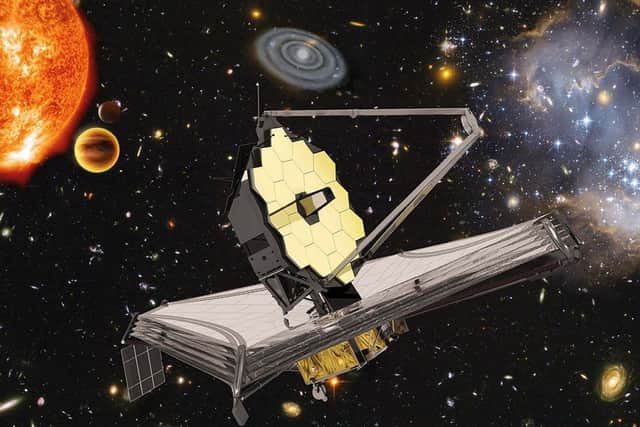First ever colour images of early universe to be unveiled in Morecambe
and live on Freeview channel 276
Scientists are to present the images with a projector on stage at the Winter Gardens in Morecambe at 4pm on July 12, with solar telescopes outside the venue to attract passersby.
This is one of only four events in the UK selected by the European Space Agency to showcase the new Webb data after an application process.
Advertisement
Hide AdAdvertisement
Hide AdThe pictures beamed back to Earth will be the first in full colour and are expected to spark global interest.


Eric Smith, Webb program scientist at NASA Headquarters in Washington said: “The release of Webb’s first full-colour images will offer a unique moment for us all to stop and marvel at a view humanity has never seen before.”
Dr Julie Wardlow from Lancaster University’s Department of Physics said: “It’s a privilege to be selected to host an event celebrating the first release of science data from the James Webb Space Telescope and we’re thrilled to be able to bring the pioneering images to Morecambe for free. I can’t wait to see the data and share the excitement with local people!”
The event will include a show inside the university’s mobile inflatable planetarium called LUniverse, which visits 60 schools a year as well as local festival and events.
Advertisement
Hide AdAdvertisement
Hide Ad“The images will be shown straight from NASA and ESA HQ to the main stage as they are released. We will then import the images into our planetarium dome so visitors will get a fully immersive experience. Weather-permitting, we will set up our new projecting solar telescopes outside the venue to generate interest.


“As well as the planetarium we will have a variety of space-based activities for the whole family, and you can drop in anytime until 7pm (last entry 6.30pm) to explore the universe with us.”
The historic images will also be exhibited locally at places such as libraries, tourist information centres and community centres. They will also be included in the touring LUniverse planetarium shows which visit local schools and community events.
Orbiting a million miles from Earth, the James Webb Telescope has an ambitious mission to peer back in time within a mere 100-200 million years after the Big Bang.
Advertisement
Hide AdAdvertisement
Hide AdEquipped with a 6.5m-wide (21ft) golden mirror and four super-sensitive instruments, Webb will be able to detect light that has been travelling through space for more than 13.5 billion years.
Launched last year and a hundred times more powerful than the Hubble space telescope, the James Webb mainly views the cosmos in the infrared spectrum, allowing it to gaze through clouds of gas and dust where stars are being born.
It will study every phase in the history of the universe, from soon after the Big Bang to the evolution of our own solar system.
In addition to imagery, Webb will capture spectroscopic data — detailed information astronomers can read in light – and will be the premier observatory of the next decade, serving thousands of astronomers worldwide.
Advertisement
Hide AdAdvertisement
Hide AdWebb is an international collaboration between NASA, ESA (the European Space Agency), and the Canadian Space Agency (CSA).
Register for the free event at https://www.eventbrite.co.uk/e/live-first-science-images-from-the-webb-telescope-planetarium-shows-tickets-375317062437